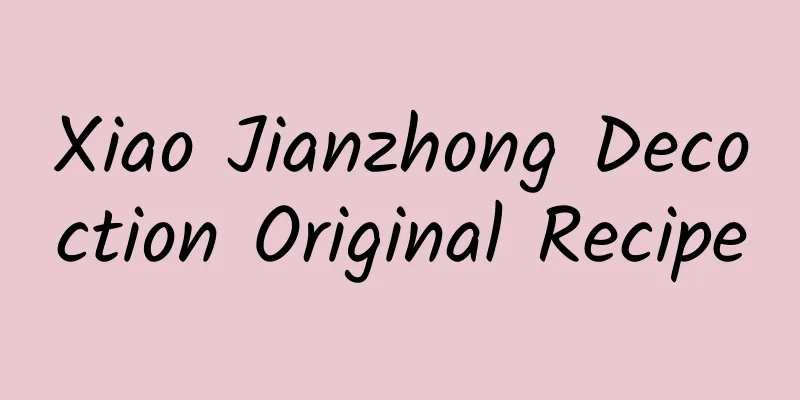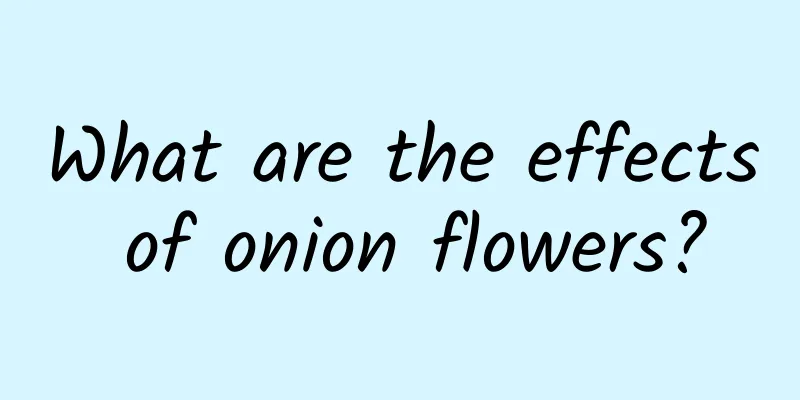Xiao Jianzhong Decoction Original Recipe

|
The book "Classic Prescriptions and Syndromes" is an essential textbook for TCM clinicians and TCM enthusiasts to study prescriptions. So what are the original formula composition, medical case clauses, usage methods and dosage, as well as explanation and theory of Xiao Jianzhong Decoction? The editor below will explain it to you in detail. [Original formula composition] Peel cinnamon twigs, 3 liang (9 grams), roast licorice, 2 liang (9 grams), split red dates, 12 pieces, peony flowers, 6 liang (18 grams), slice ginger, 3 liang (9 grams), and 1 liter (70 ml) of maltose. [How to take] Take the above six ingredients, add seven liters of water, boil and take three liters, remove the quench, add candy, and simmer again on low heat until it is gone. Take one liter while still warm, three times a day. [Explanation of treatment formula] Syndrome differentiation and treatment: Weak spleen and stomach, sinking of middle qi. Treatment: Warm and nourish the spleen and stomach, promote Yang and nourish the blood. Recipe meaning: Xiao Jianzhong Decoction is composed of Guizhi Decoction with twice the amount of peony flower and maltose. Polymaltose is the main ingredient, which is pungent and warm and enters the spleen, warms the middle, nourishes yin and blood, and harmonizes the interior with light or heavy ingredients to relieve urgency; cinnamon twig warms the spleen yang, red peony root harmonizes the blood and relieves pain, and is paired with maltose to transform the yin with sour and sweet to nourish the blood. cinnamon twig and licorice are the meaning of cinnamon twig and licorice soup, which can transform the yang with pungent and sweet ingredients to calm palpitations. Ginger slices and red dates are pungent, sweet and warm in nature, and they warm the middle, nourish yin and blood, and serve as adjuvants. [Dialectical key points] Our prescription is made of Guizhi Decoction with twice the amount of peony flower and maltose. The key to the famous prescription of Guizhi Jiawei is not to replenish the deficiency, but to build up the middle. The application scope of my prescription is: abdominal pain due to yin deficiency and internal heat, the pain comes and goes, the pain is relieved by pressing, and the abdomen is soft. Dry mouth but must like hot drinks in winter, pale red or pale white tongue, white and clear tongue coating, deep and slow pulse. In clinical medicine, self-treatment of night sweats, yellow obesity, deficiency syndrome, yin deficiency and internal heat type abdominal distension and other diseases can be used as long as the syndrome is diagnosed as spleen and stomach deficiency and sinking of middle qi. Both my prescription and Guizhi Gancao Decoction can treat palpitations. My prescription treats palpitations caused by insufficient heart qi and blood, with palpitations, irritability, and shortness of breath as the main characteristics. Treatment focuses on tonifying qi and blood; while Guizhi Gancao Decoction treats palpitations caused by deficiency of heart yang, with palpitations and desire for pressure as the main characteristics. Treatment focuses on warming and tonifying yang qi. [Zhongjing Fanglun clause] Article 100 of "Treatise on Febrile Diseases": In case of typhoid fever, if the Yang pulse is sluggish and the Yin pulse is deep, and there is acute pain in the abdomen, first give Xiao Jianzhong Decoction; if the pain does not subside, Xiao Chaihu Decoction should be used. Article 102 of Treatise on Febrile Diseases: If a patient has suffered from typhoid fever for two or three days and feels palpitations and restlessness, Xiao Jianzhong Decoction is the main treatment. [Commentary on the Prescriptions] 1. Cheng Wuji's "Explanation of Treatise on Febrile Diseases": The spleen is earth, and should be located in the center of the heart. It governs the central plain, governs the middle burner, produces the nourishment and defense system, and circulates body fluids. If there is any disorder, the nourishment and defense system will lose their place of growth, and the body fluids will lose their place of circulation. This soup must be used to warm the middle organ, hence the name Jianzhong. Glue and malt taste sweet and warm, while licorice tastes sweet and neutral. If the spleen wants to be relaxed, it is necessary to eat sweet food to relax it. To strengthen the spleen and stomach, sweet food must be the main factor, so gluten and malt are used as the main ingredient and licorice is used as the secondary ingredient. Cinnamon is pungent and hot, and pungent means dispersing and moistening. If the Ying and Wei are insufficient, it can moisten and disperse them. Peony flower is slightly bitter and cold, and sour means astringent and purge. If the body fluids are insufficient, it can astringe and circulate. That is why cinnamon and peony are used as adjuvants. Ginger slices taste spicy and warm, while red dates taste sweet and warm. The stomach is the source of Wei, and the spleen is the basis of Ying. The "Huangdi Zhenjing" says: Ying comes from the middle burner, and Wei comes from the upper burner. Wei is Yang, so if it is deficient, it must be supplemented with spiciness; Ying is Yin, so if it is deficient, it must be supplemented with sweetness. When spiciness and sweetness match, the stomach and intestines will be healthy and the Wei and Ying will be unblocked. Therefore, ginger and jujube are used as the messengers. Some people say that Guizhi Decoction replenishes deficiency but has a small number of peony flowers, while Jianzhong Decoction warms the interior but has a large number of peony flowers, but they do not know the relationship between the two. If the evil is close to the skin, then the dosage should be reduced. Guizhi Decoction with Peony Flower and Guizhi is used together to dispel the evil, which is not the same as Jianzhong Decoction. The evil of confidants is far away, so the rule is to make them obey you. In Jianzhong Decoction, peony flower is added with maltose to strengthen the spleen and stomach, and it is not to be used together with cinnamon twig. The "Inner Canon" says: If the distance is close, the number of odd and even numbers should be small; if the distance is far, the number of odd and even numbers should be large. This is what it means. 2. Fang Youzhi's "Treatise on Febrile Diseases" says: Xiao Jianzhong is Guizhi Decoction with twice the amount of peony flower and added jelly. Guizhi Decoction strengthens Yang and consolidates the Wei. When the Wei is consolidated, the blood circulation will be harmonious. The flower of peony is twice as sour as that of other herbs, which can restrain yin. When yin is restrained, yang will return to its normal state. Adding glue and syrup can moisten the soil, and when the soil is moist, all things can grow. To build is to establish the law. To establish the law is to hit the center, not biased towards the center. The key is to be unstoppable. Is this what it means? 3. The Prince Charming continued from "Jiangxueyuan Ancient Prescriptions Selection and Annotation": Jianzhong means to strengthen the Qi of the middle. It is called the small one, and its taste is sour, sweet and mild in nature, and can only build up the vital energy of the middle burner. The previous Guizhi Decoction was composed of peony flower and cinnamon twig, while the current Jianzhong Decoction is composed of cinnamon twig and peony flower. The meaning emphasizes sour and sweet, and is specifically used to harmonize the yin of the blood. Peony flowers and licorice root have the wonderful effect of complementing each other. Gum is the sweetness of crops, and cinnamon twigs are yang wood, which means that Jia Yi turns into earth. Ginger and dates help the spleen and stomach to circulate body fluids. The soft yang in the blood comes from the stomach. 4. Zhang Lu's "Treatise on Febrile Diseases": Guizhi Decoction, Gathering Peony Flower and Guizhi in equal parts, Peony flower is used with Guizhi to treat Wei Qi; the editor of our book doubles the peony flower, uses Guizhi to treat Rong Qi, and adds glue to soothe the spleen, so it is called Jianzhong, then its function is very different. 5. Li Zhongzi's "Summary of Cold Damage": The spleen is located among the four internal organs. It produces the nourishing and defensive qi and circulates body fluids. If there is any disorder, the nourishing and defensive qi will not be produced and the body fluids will not circulate. This soup is sweet and warm, good for shaping the Central Plains, and has a creative spirit, so it is called Jianzhong. If the spleen needs to be relaxed, eat something sweet to relax it. Therefore, use pungent and warm gum as the main ingredient, and licorice as the secondary ingredient. The pulse is deep and wood-strong, which is the enemy of earth. It can be controlled with cinnamon and peony flowers as adjuvants. It is suitable to be pungent in nature to invigorate the Wei and sweet in nature to replenish the Ying, so ginger and jujube can be used as messengers. 6. Mei Guoqiang's "Lectures on Treatise on Febrile Diseases": This prescription is made of Guizhi Decoction with twice the amount of peony flower and maltose. Due to the different composition principles, it changes from a prescription for tonifying deficiency to a prescription for strengthening the middle. In Guizhi Decoction, cinnamon twig and peony flower are equal in amount to relax muscles, dispel wind, and regulate the Ying and Wei. In this recipe, maltose is used as the main ingredient, and the amount of peony flower is twice that of cinnamon twig, so that its sweet and sour properties can be maintained, which can circulate the Ying and Wei and nourish the central plains, thereby invigorating the source of blood and qi biochemistry. What's more, the unique dosage of peony flower further demonstrates its ability to relieve pain regardless of severity or urgency. Therefore, it can warm the middle and strengthen the spleen, nourish yin and blood, balance yang and yin, and regulate blood and qi. [Famous Chinese Medicine Cases] 1. Xu Shuwei's Medical Case Treated a fellow villager named Qiu Huo, who suffered from typhoid fever, fever, headache, thirst and loss of appetite. The pulse is floating, rapid and weak, and the pulse below the radial side is slow and weak. Xu said: "Although it is the symptom of Wuyao, the pulse is weak and slow. Zhongjing said: 'If the pulse is slow in the middle of the pulse, it means that the vital energy is insufficient and it is not time to sweat.'" I added Chuanxiong and Huangqin to Xiaobian, and the pulse was still the same at noon. His family asked for sweating medicine and spoke in a somewhat rude manner. Xu Renzhi only used Jianzhong to transfer the camp. On the fifth day, there was a response in the middle of the wrist area, so I took two doses of Ma Huang Tang. He suddenly became crazy, then calmed down a little and slept a little, and started sweating. It is believed that medical practitioners should observe the patient's exterior and interior for the right time. If they do not follow the sequence, the effect may be temporary, and the five internal organs may be damaged, which will hasten the retreat of the cold. In that case, the effect is of no value. 2. Liu Duzhou's medical records Wang, male, 37 years old. I suffer from chronic hepatitis, dull pain in the liver and general fatigue. Taking blood-activating and collateral-opening medicines is ineffective. The tongue is pale and the pulse is deep, and it feels weak when pressed. This is because the spleen is weak and cannot nourish the wood, so the liver blood is abundant and causes dull pain. The classics say: "The liver is in pain and urgent. Eat something sweet to relieve it." The treatment method is to use sweet food, so the prescription of Xiao Jianzhong Decoction is prescribed. After taking 3 doses, the pain was cured. [Changsha City Folk Song] Jianzhong is Guizhi Decoction, double the amount of peony root and add malt, which is an excellent recipe. Take one liter and six liang of peony root, and it will have a very long effect on relieving palpitations and abdominal pain. |
<<: How long does it take to treat uterine cold with Chinese medicine?
>>: Composition of Xiao Jianzhong Decoction
Recommend
Ailao Mountain is not only a place of sorrow for scientific research victims, but also a place of brilliant life stories
Ailao Mountain has entered the public eye because...
Why is it so difficult to kill the “invincible” cockroach? Let’s see the battle between humans and cockroaches →
Cockroaches, scientifically known as Blatta, are ...
The little secret of the park: making the city "alive"
Biodiversity Conservation From the Wild to the Ci...
The old man diving in Tianjin is all over the news. Archaeological evidence shows that people have been diving there at least 2,500 years ago!
Recently, the Tianjin diving grandpa has become p...
The efficacy and function of ground precious grass
In traditional Chinese medicine, ophiopogon japon...
Interesting story: Is the terrifying nightmare really an attack by demons and monsters?
The reason I bring up this issue again is that I ...
Effects and functions of Huoxiang Chinese medicine
Everyone is familiar with Huoxiang Zhengqi Water....
The efficacy and function of round-leaved sundew
Round-leaved sundew is very familiar to everyone....
So scary! This "snake" has miraculous effects on both men and women
Cnidium monnieri, also known as wild carrot seed,...
Why do I want to cry when I have a quarrel? I feel so much empathy...
Editor: Dong Xiaoxian...
Drink tons of plain water, but it’s not as good as this to quench your thirst?
Audit expert: Wang Guoyi Postdoctoral fellow in N...
The efficacy and function of Kudzu
Kudzu vine is a kind of traditional Chinese medic...
The little things you ignore on the road cause more than 8,000 deaths every year
An eMule is indispensable on the road to success ...
Are you always getting electrocuted in winter? Here are some easy tips to help you avoid static electricity!
Winter is coming Do you often experience sudden &...
The original recipe for making Morinda officinalis wine is this!
Among the ancient health-preserving methods, medi...









